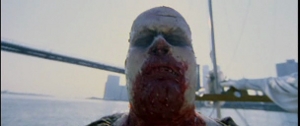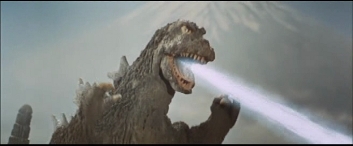
It’s an old story but I’ll tell it again: George Romero’s Dawn of the Dead premiered in April, 1978. By September, it reached Italy under the title Zombi, because alteration doesn’t translate well and, hey, at least the title’s illustrative. I might’ve gone with Zombis myself, but nobody asked. Instead, hoping to cash in on Dawn of the Dead/Zombi‘s international success, Italian action/Western/thriller/giallo director Lucio Fulci gave us Zombi 2 the very next year.
Released in America in the summer of 1980 under the title Zombie, Fulci’s film (which I’ll refer to as “Zombi 2” from now on just for the sake of clarity) became a matinee and drive-in sensation. It’s another case of the right film in the right place at the right time, finding its natural audience in the English-speaking world’s teenagers. Between Night and Dawn, Romero managed to raise a whole generation of horror fans who didn’t want to wait ten years for the next zombie movies, damnit. We wanted them now. So what if half the cast have their lines dubbed? Some of us put up with way worse just to get our giant monster movie fix. Continue reading Zombi 2 (1979)

 The embodiment of writer Brian Pulido’s fetishes and less than orthodox ideas about female empowerment, Lady Death epitomized, if not largely kicked off, the “Bad Girl” craze of the ’90s. A generously endowed woman who slaughtered her enemies and even those who just mildly irritated her, Lady Death was almost designed to be the patron saint of “sex n’ violence.” Her origin story, which had her burned alive by medieval villagers who held her responsible for the crimes of her Satanist father and which saw her eventually lead a coup against Satan himself, didn’t end with her becoming a hero pledged to defend the helpless. Instead, cursed to remain in Hell as long as one person remains alive, she expedited the process herself by setting out to wipe out the human race. When we’re first introduced to her, she’s doing so by seducing a telepathic child abuse victim in his dreams, goading him into becoming a serial killer, and manipulating a high-tech attempt to mentally cure him in order to turn him undead and thus initiate a zombie apocalypse. Really, in her first appearances Lady Death made Doctor Doom look bush league.
The embodiment of writer Brian Pulido’s fetishes and less than orthodox ideas about female empowerment, Lady Death epitomized, if not largely kicked off, the “Bad Girl” craze of the ’90s. A generously endowed woman who slaughtered her enemies and even those who just mildly irritated her, Lady Death was almost designed to be the patron saint of “sex n’ violence.” Her origin story, which had her burned alive by medieval villagers who held her responsible for the crimes of her Satanist father and which saw her eventually lead a coup against Satan himself, didn’t end with her becoming a hero pledged to defend the helpless. Instead, cursed to remain in Hell as long as one person remains alive, she expedited the process herself by setting out to wipe out the human race. When we’re first introduced to her, she’s doing so by seducing a telepathic child abuse victim in his dreams, goading him into becoming a serial killer, and manipulating a high-tech attempt to mentally cure him in order to turn him undead and thus initiate a zombie apocalypse. Really, in her first appearances Lady Death made Doctor Doom look bush league.



